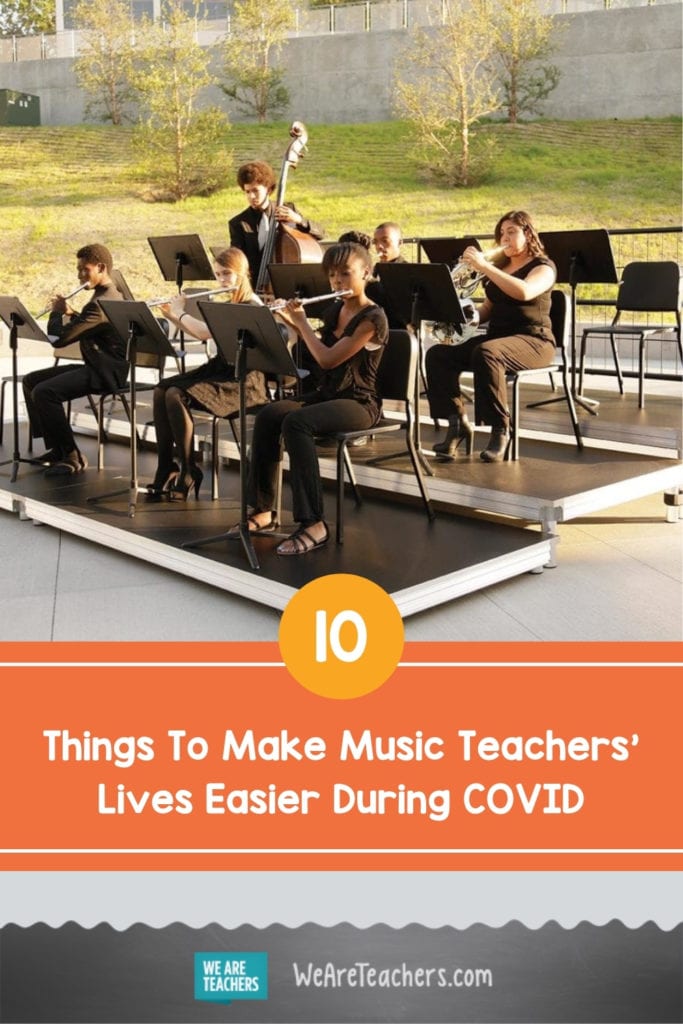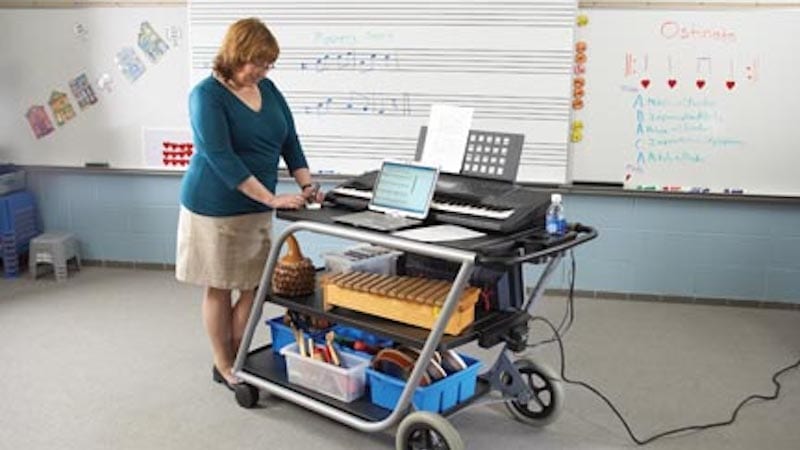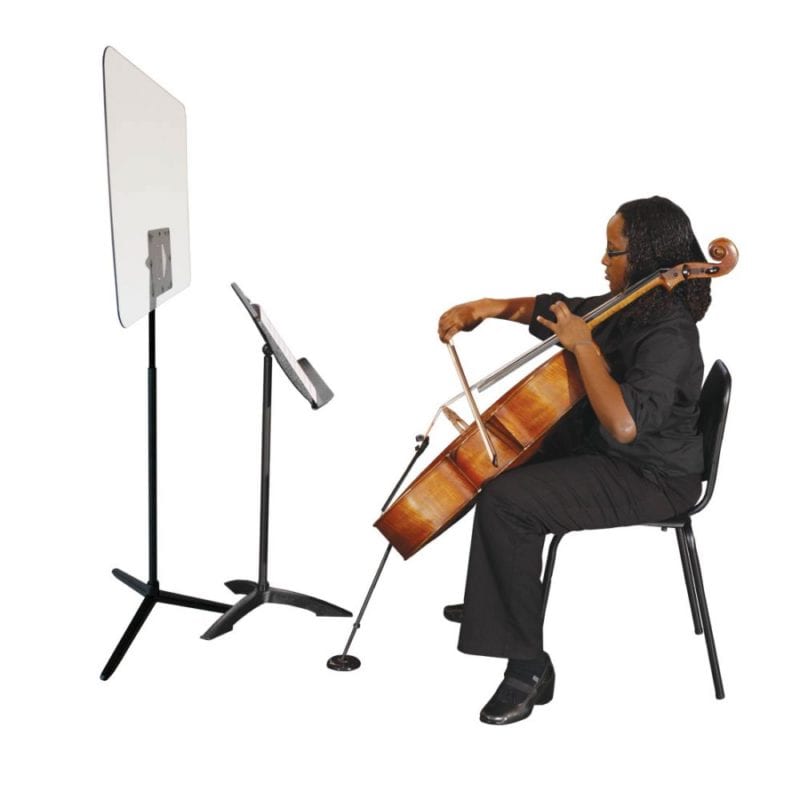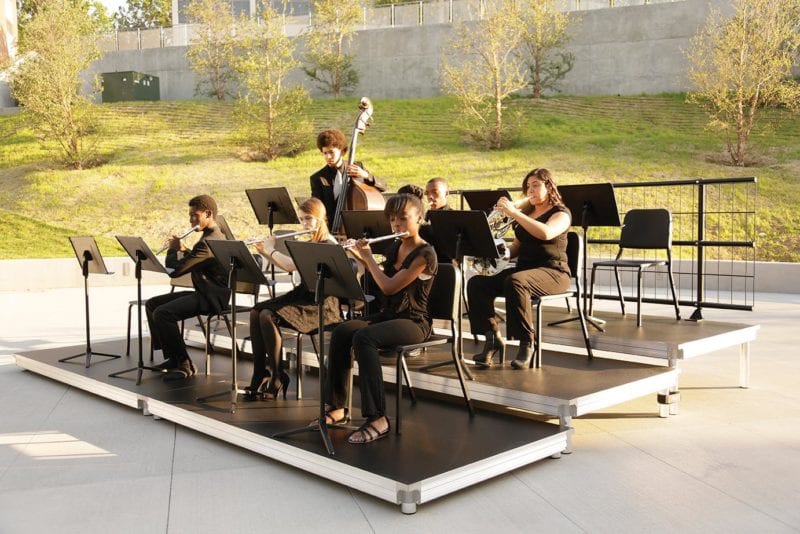It’s no easy feat to make music class happen in a pandemic. You have rules against singing, social distancing mandates, ventilation requirements, and more. It’s tough for sure, but music educators across the country are finding a way. We found out the strategies and tools making music teachers’ lives easier during COVID.
1. Having everything together on a cart
There was a time when being a “cart teacher” was the last thing you wanted, but this is 2021. Lots of music teachers are now having to go classroom to classroom in order to keep the same groups of students together and minimize exposure. You know what makes that a whole lot easier? A cart. Elementary music teacher Stephanie Magnusson shares what’s on her cart:
“CD player, bluetooth player, bin with sticks, bin with Sound Shapes, bag with shakers, hand wipes, sanitizing spray, paper towels, dirty bin for used instruments, music stand, drum for movement games, portable keyboard, a bin for my books and notebooks, a bin for loose instruments or tools for teacher (right now it has a stick man, some batteries, and a woodblock), dry erase pens, a clipboard with lesson pages, my keys, a magical unicorn pointer, a first aid kit, and a timer.”
2. Adjusting the schedule to include time outside the music room
OK, so it’s not as convenient as every Thursday at 1:20 p.m., but getting the schedule nailed down is key. For Magnusson, that means she sees grades 2-6 once every other week in person on an A/B rotation, so it’s just half the class at a time. They also get two asynchronous lessons and one “push and play,” an activity organized by her and pushed out to teachers to do on the week they do not have music in person.
3. Finding alternatives to singing (hint: it’s all timbre)
In Magnusson’s school, singing isn’t allowed, but she’s finding ways to develop their vocal cords nonetheless. “I am incorporating use of different timbres of voice to get them using different sounds,” she says. “I start with a hello song in K and 1, and we do it multiple times, first chanting in a normal speaking voice, then in a high Mickey Mouse-type voice, and then in a low voice.”
4. Using found sounds around the house and classroom
When you can’t sing, instruments are a natural go-to, but the CDC recommends limiting sharing. For Magnusson, that means using a lot of “found sounds.” When students were at home, she had them find things in their house that made a particular noise (something that jingles, something that makes a shaking sound, find something that sounds like a drum). Now at school, students “play” their desks or their pencils as they work with rhythms.
5. Incorporating the best cleaning hacks (say it with me: sanitizing wand)
For bigger instruments like drums, Magnusson uses a sanitizing wand. Sticks and shakers work well because they can easily be wiped down (she recommends a clean and dirty tub for these). She’s also wrapping her xylophones and glockenspiels in plastic.
6. Providing barriers to separate staff and students
The Centers for Disease Control recommend installing “cleanable, transparent shields or other barriers to physically separate music staff and students.” A plastic shield that can later be converted for use as a music stand is a solid investment.
7. Defining 6 feet apart with visual cues
Our students are getting pretty good at figuring out what 6 feet of distance looks like, but music teachers sometimes have to prove it’s in practice. Magnusson uses sidewalk chalk on the rug to help students who have trouble staying in their designated area. Platforms or risers marked with masking tape can also work well.
8. Making virtual learning as interactive as possible
Even those who are back teaching music in person often still have virtual components. Magnusson recommends lots of movement to keep kids active and engaged. She adds, “We had music instrument kits that went home with all students K-6 that included a small drum, a shaker, some rhythm sticks, and a scraper. I also used stuffed animals for a circle game so that they could play at home.”
9. Sharing books that connect to your music curriculum
Music teachers have always used literature connections, but it’s been even more of a lifesaver during COVID. “Words connected to rhythms are very powerful,” says Magnusson, whose student teacher uses books like Love by Matt de la Peña and Pigeon Needs a Bath by Mo Willems for her push and plays to reinforce rhythm reading and writing.
10. Taking music class outside
Moving class outdoors can solve a lot of your problems. And the CDC actually recommends outdoor/open environments specifically for music and performing arts classes. Bummed you can’t do your annual concert? Outdoors is a great option for performances.
Planning to go outside and play? Get 30% off select Wenger products like StageTek® Staging now through March 31.





